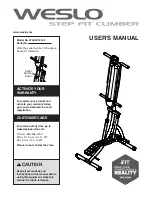
Data ultimo aggiornamento: 04/04/2018
Pag. 15 di 60
PROPANE CYLINDERS
Propane cylinders are constructed of either aluminum or steel. We
recommend aluminum because it is lighter and guards against rusting. The
cylinder used on machines is classified as a 4E240 cylinder. It’s rated
capacity is 9,1 kg (20 lbs). and this designation refers to the model of the
cylinder. Actual propane capacity achieved during filling can be less than,
equal to, or slightly more than 9,1 kg (20 lbs).
The propane cylinder used on the machine is a motor fuel cylinder as listed
by the Department of Transportation. Unlike the common 20-lb propane
outdoor grill cylinders (which are not legal for use on propane buffers), the
motor fuel cylinder has a number of safety systems designed into it to ensure
your safety at all times.
There are two types of 20 lb. motor fuel cylinders.
• Liquid draw
• Vapor draw
The liquid draw cylinder is used on larger vehicles like forklifts.
These machines have special vaporizing carburetors to allow the propane to
change from a liquid to a gas before being burned in the combustion
chamber.
The vapor draw cylinder is used on small machines. The vacuum generated
by the engine draws up the propane gas vapor through the fuel system.
The propane machine has got a vaporizer system. This system takes oil from
the engine and passes it through the regulator. The oil adds heat to the
propane allowing it to vaporize liquid propane within the regulator. This allows
us to utilize a liquid cylinder.
REFUELING CYLINDERS
WARNING:
Tanks overly full can damage the fuel system and create a fire
hazard. Do not overfill the tanks
WARNING
: Propane cylinders should only be filled by qualified propane
dealers. Only use only safety fill cylinders that guard against overfilling with a
unique safety stop fill valve that automatically limits the content to 80%
capacity. The other 20%, which is about 4” (10 cm) from the top of the
cylinder, is called the vapor space or headspace.
WARNING
: If there is no headspace to allow for fuel expansion, the
pressure relief valve will open, releasing propane gas into the atmosphere.
This is a very dangerous and volatile situation as there is always the
possibility that enough of the vented gas could find its way down to the floor
and come in contact with a pilot light from a furnace, hot water heater, or
other source of ignition. DO NOT release or bleed propane inside a building.
WARNING
: The boiling point, or temperature at which liquid propane changes
into a gas, is -44º F (-42º C). Exposing unprotected skin to propane gas or
liquid could result in frostbite injury. Always wear gloves when filling a
propane cylinder.
STORING CYLINDERS
WARNING:
Turn off tank to stop propane machine. Remove propane tank
when not in use.
WARNING:
All new cylinders should be vented and purged of air per
manufacturer’s instructions before use. Never bleed propane cylinders
indoors.
WARNING
: When not in use, propane cylinders always should be stored
outside in an upright position in a secure, tamperproof, steel mesh storage
cabinet. This cabinet may be located next to the building but with at least five
feet (1.5 m) of space between the cabinet and the nearest building opening
(door or window).
WARNING
: Do not install the cabinet near a stairway or street elevator as
vented propane gas will seek a lower level since it is heavier than air and
could find its way into the basement of the building.
WARNING
: Do not store cylinders full or empty inside a building or inside a
vehicle. Do not smoke or use a device with an open flame when handling or
transporting propane cylinders.
TRANSPORTING CYLINDERS
WARNING
: When transporting cylinders to a propane dealer or to a job, make
sure the cylinders are securely fastened and standing in an upright position
with the service valve closed.
WARNING
: Avoid dropping or banging cylinders against sharp objects. The
propane cylinders are sturdily constructed but a series of hard jolts could
cause damage.
WARNING
: Please note that any cylinder that has been filled is always
considered full, no matter how little propane gas remains in it. This is
because even when all liquid has evaporated into vapor there is still some
propane gas vapor left in the cylinder. Because this remaining fuel is
flammable, an empty cylinder should be treated with the same careful
procedures as one that is filled to the 80% level with liquid propane. The only
time that a cylinder is considered empty is when it is new, before it has been
filled with propane.
















































